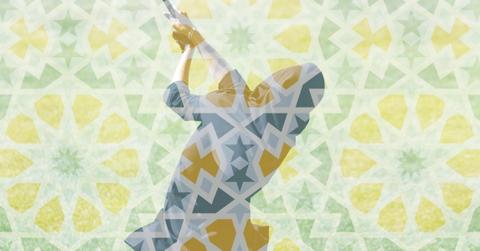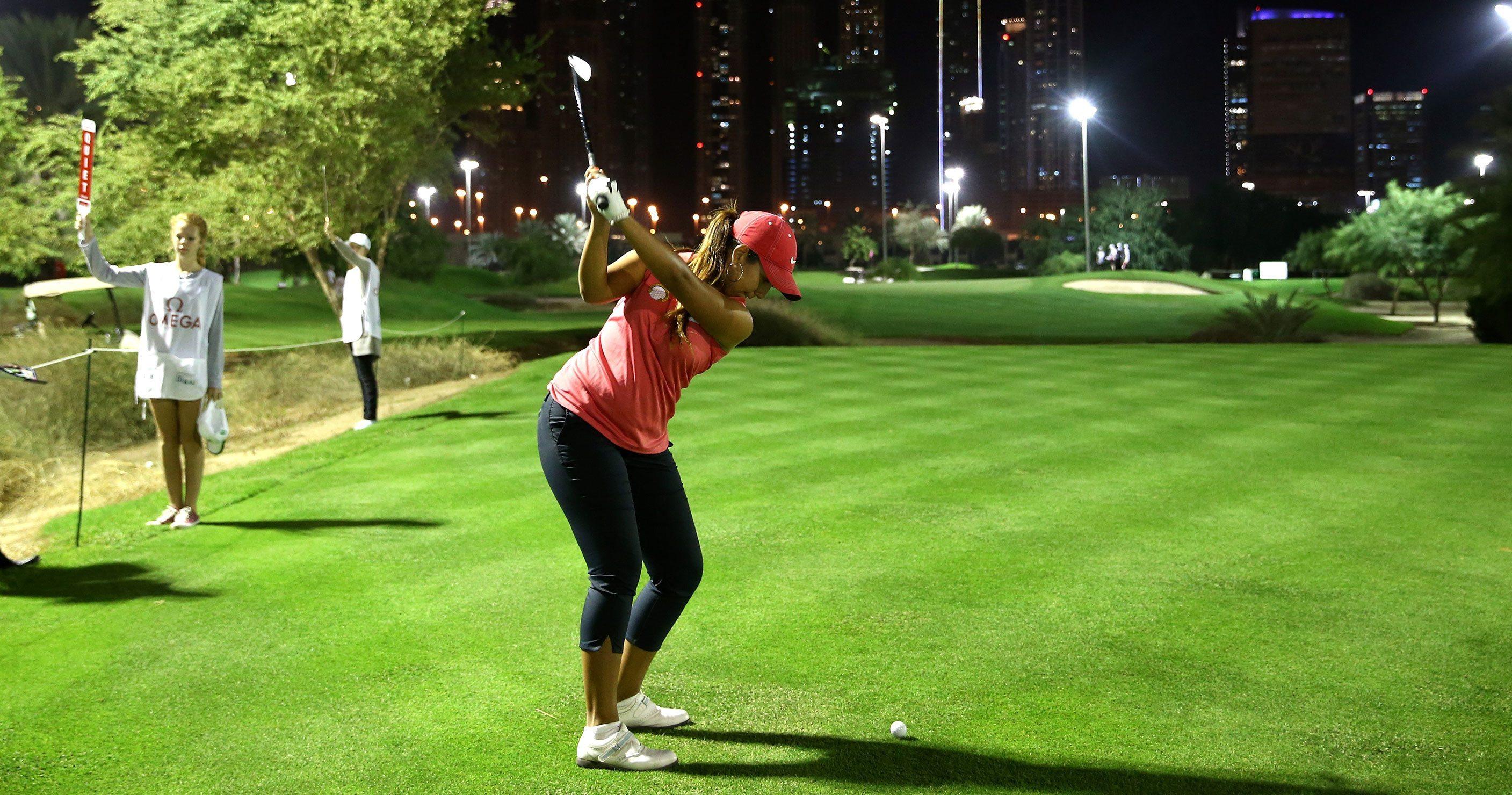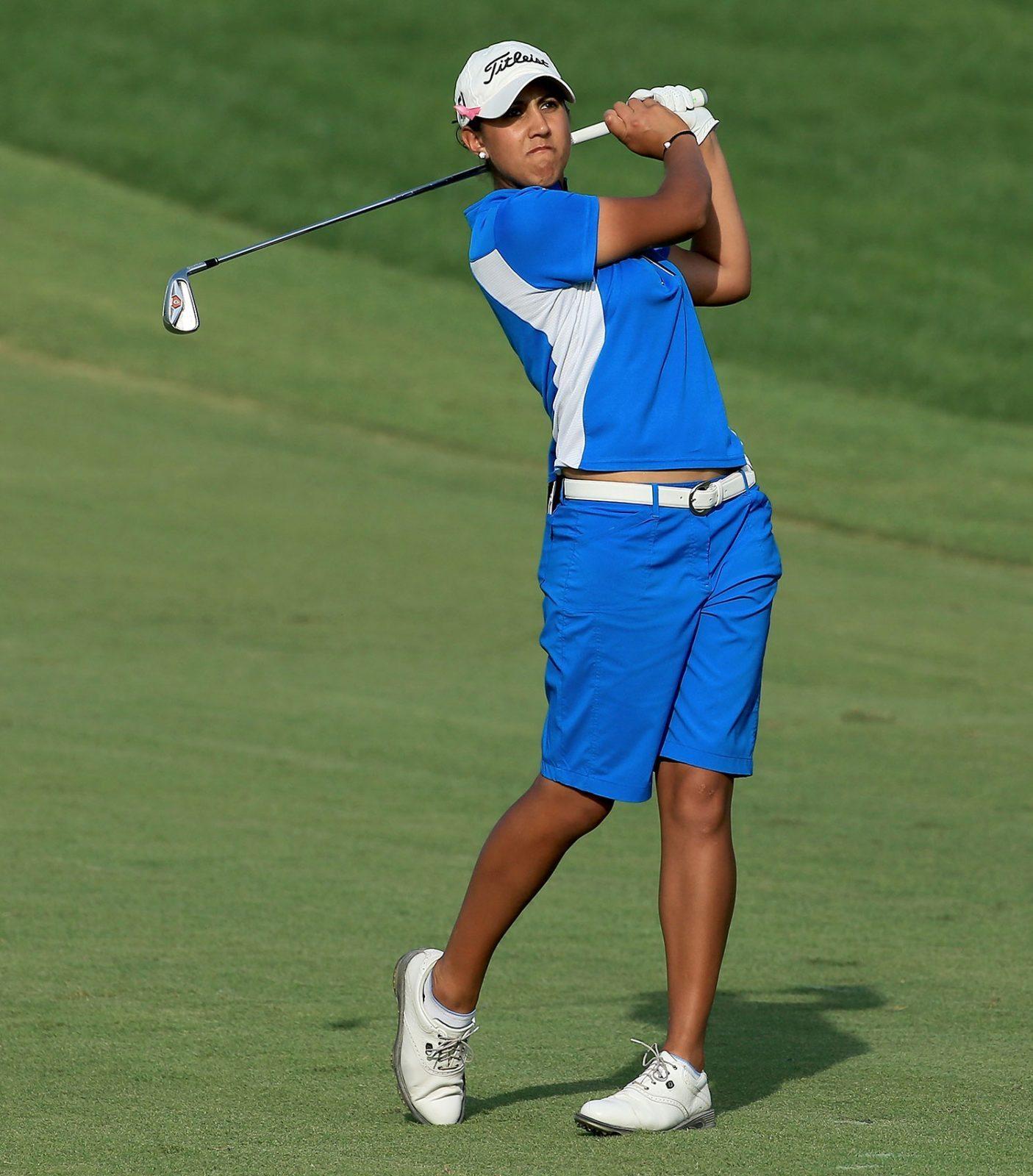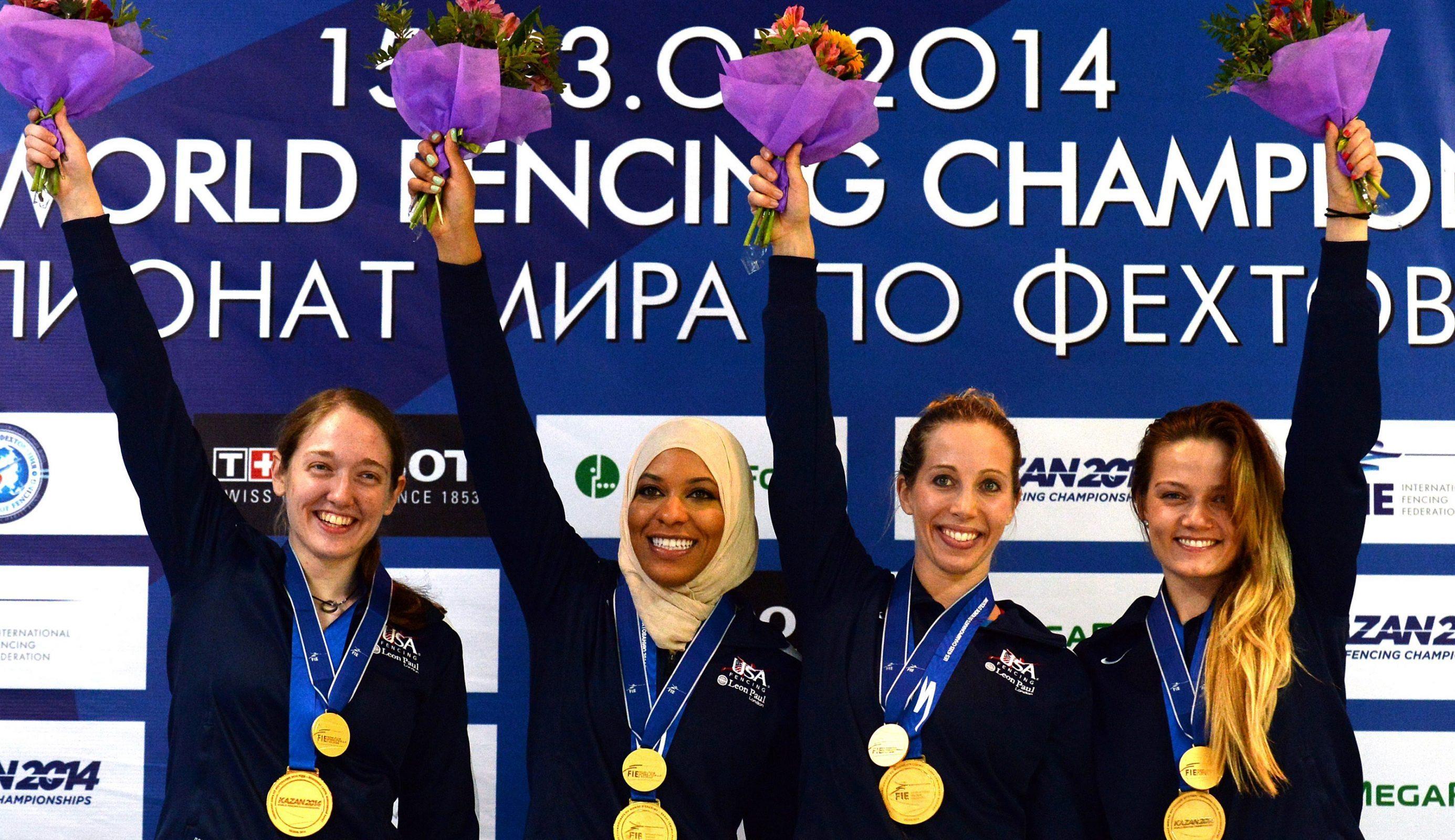
Can Golf Start A Revolution? Muslim Golfers & The LPGA
It was the 7th century and the Prophet Muhammad and his wife Aisha were walking down the road. He turned to her, perhaps with a smile, and said, “let’s race!” So they took off running as fast as they could—and she won. A few years later the scene played out again, but this time was different. She’d gained some weight, and he ended up winning. With a good-natured laugh he turned to her, referenced their first contest, and said “This is for that!”
That’s one version of the story as it’s told now, and for many the tale is an example of the positive relationship between the Prophet and his wife, the playful fun they enjoyed and the love they shared—not to mention the benefits of keeping fit, which is encouraged in Islam.
But if athletics are encouraged, the issue of Muslim women and sports can get complicated. There are guidelines regarding modesty and behavior that raise questions over participation in certain sports, plus cultural issues both inside and outside of Islam that bring pressures to bear. Beach volleyball? Probably not, at least not at the pro level. Gymnastics? Tricky. Boxing? Some people will take issue.
And then there’s golf. Players can be covered on course, satisfying modesty requirements. Men and women can play separately, accommodating rules in certain countries. The game isn’t overly violent or dangerous, in line with some Muslim perspectives on sports. In many ways, golf seems to be the ideal game for Muslim women—so where are they?
There are only two Muslim females playing professionally, and “why” turns out to be a relatively complex question, one that transcends golf and goes to the relationship between Muslim women and sports in general.
“I think that with time it’s going to get better,” says Maha Haddioui. Currently, the 27-year-old Moroccan is one of only two professional Muslim female golfers in the world. Along with Sahra Hassan, a Welsh golfer whose father is from Pakistan, Haddioui plays on the Ladies European Tour, and she’s optimistic about the future: “In countries like Morocco and Tunisia, I think we’re going to have a good field of players with time, but for now it’s still a men’s sport in Arab countries.”

Maha Haddioui during the Challenge Match on the par-3 floodlit course as a preview for the 2014 Omega Dubai Ladies Masters at Emirates Golf Club
Hassan agrees, pointing out that both she and Haddiuoi are greeted by young Muslim girl fans in Dubai, for example, where the LET stops for the Omega Dubai Ladies Open. Just seeing two Muslim women pros on tour is helping to grow the women’s game in Arab countries, Hassan says, and she’s probably right.
It’s tough to get exact numbers on Muslim women golfers, but from conversations with Haddioui, Hassan and others, there’s no doubt that many do play—and that more want to. One issue they face is a lack of golf courses, which also helps to explain why there aren’t more Muslim male golfers. Iran, Afghanistan, Uzbekistan, Azerbaijan, Jordan, Lebanon, and a few others have only one course, according to the R&A, golf’s governing body outside of the United States. Israel has two courses, so does Kuwait. Qatar has three. Oman, six. Obviously, a few of the places on that list have bigger issues at the moment than a lack of golf, while in more stable areas like Morocco (36 courses) and the United Arab Emirates (22) the game is growing quickly. As a whole, the Middle East and North Africa are part of a region in which, according to recent studies by HSBC and the R&A, the game is actually getting stronger than it is in the West.
One of golf’s potential attractions to Muslim women is that it readily accommodates the traditional Islamic tenet of modest dress. Indeed, a woman wearing the abaya and niqab, the dress and headcover combination that shields all but the hands and eyes, is hardly more constrained on course than Victorian females were in their corsets, long skirts and blouses and jackets. And many Muslim women opt to wear only the hijab, a headscarf that covers the head, neck and chest, which some pair with modern sportswear (as Saudi Arabia’s first-ever female Olympian Sarah Attar did in her track and field events at the London games). There are even companies making sports-specific hijabs, with brands like Capsters using breathable materials and sporty colors and designs.

Sara Hassan plays her second shot a the par-4, 14th hole during the third round of the 2013 Omega Dubai Ladies Masters on the Majilis Course at the Emirates Golf Club
Neither Hassan nor Haddioui wear the hijab, both women wear shorts if it’s hot on course, both dress in standard (what might be called “Western”) golf wear, and both say they know that some people might have a problem with all of that. Still, the only criticisms either woman says she has met have been cultural, not expressly religious.
“When I decided I was going to be serious about golf, my parents were really supportive about my traveling the world, being independent,” Haddioui says. “I was allowed to travel with the golf team, and I know a lot of families wouldn’t accept that. That’s something that’s preventing sports in general from developing in the Arab world because women are not allowed to go out by themselves. Some people used to tell my parents, ‘Aren’t you scared? She’s going all over the world!’ My parents were like, ‘Why would I be scared? She’s just the same, only she comes from Morocco.’ They’ve always thought that way. I know in some families the boys would be allowed to go out but not the girls because it would send the wrong message about the girl. Parents don’t want to give a bad image of their family, and it always comes down to protecting the girl. People assume we need protection more.”
For Hassan, she says she faced some expectations from family, but the concerns sound like those of some traditional non-Muslim families as well.
“A few people have said, ‘Oh she shouldn’t be doing sport, it’s not really a thing that Muslim girls should be doing.’
“A few people have said, ‘Oh she shouldn’t be doing sport, it’s not really a thing that Muslim girls should be doing.’ They’ve just got it in their heads that you should be married and be a housewife, that sport is more of a guys’ thing to do,” she says. “And if you’re not going to be a housewife you should do a medicine degree, be a doctor or a lawyer; they just don’t have sport in their minds. Even my family, my grandparents, aunts and uncles, some of them felt this way. I said, ‘This is going to be my career. You’re going to have to accept it.’ They eventually did of course.”
Both women grew up in what could be termed relatively mainstream areas, Haddioui in the tourist-and-golf-friendly Moroccan city of Agadir and Hassan in Newport, a blue collar town in Wales, and both say religion has never been a big factor in their sports careers, certainly not from their own perspectives.
“I know a golfer who wears the hijab and plays golf with that,” says Haddioui. “Golf is one sport where you can dress in respect to your religious beliefs, but I’ve always believed that religion is in your heart so it shouldn’t be a matter of how you dress. I’m Muslim but I don’t cover my hair and I wear shorts; I don’t need to do extra things to prove myself.”
As for anyone who invokes Islam to justify restrictions on women, “I think they’re just using religion,” she says. “There is nothing in religion that would prevent anyone from doing sports or watching sports.”
imam john ederer agrees. An Oklahoma native who studied in Egypt and Kuwait before moving back to the States to work with various Islamic cultural centers, the imam (cultural and spiritual leader) is a self-described conservative Muslim who says that, with his community and many others, he follows Islam the way “the Prophet originally taught it; we’re preserving the original values.” And those values, he says, include women’s rights.
“Many times the Prophet’s companions would race on horses or camels or wrestle in the mosque, and everybody would watch that, both men and women,” Ederer says. “In the actual prayer sanctuary, if it wasn’t prayer time, as an act of sport men would wrestle each other… Back then men and women prayed in the same hall.”
As to why a Muslim man might object to a Muslim woman playing golf, “I can’t imagine what their problem would be,” he says, adding that there will certainly be Muslims who disagree with his perspective.
One has to look no further than to those who arrested and imprisoned Ghoncheh Ghavami this year to confirm Ederer’s statement. The 26-year-old Iranian-British woman was arrested in Iran in June while protesting a ban on women watching sporting events inside stadiums alongside men. Sentenced to a year in prison for protesting and attempting to attend a men’s volleyball game to watch Iran play Italy, she served five months before the charges were dismissed.
It is important to understand that Ederer and many other Muslims consider the kinds of restrictions she was protesting to be the result of “extremist interpretations” that are more a function of culture than of religion, Ederer says, and which are not in line with their own perspectives.
Reporter Neil MacFarquhar encountered evidence of restrictive attitudes when he visited Iran in 2005, and it was specifically expressed in regard to sports.
Writing for The New York Times in an article on golf in Iran, he quoted Hamidreza Taraqqi, editor of a weekly conservative paper called Shoma, as saying, “In Islam, women are considered delicate creatures, and they should have jobs and play sports with a view toward this delicacy. Women have a very high value, and by exposing themselves in different positions during sports, it damages their image, so they just shouldn’t do it.”
Despite that, MacFarquhar found that Iranian women genuinely enjoyed golf—and it appears that they still do, according to Dylan Harris, operator of Lupine Travel. Harris’ company specializes in trips to hard-to-enter destinations. He travels to Iran occasionally and even staged a golf tournament there in 2012, an event he’s trying to repeat.
“There is not a strong golf culture in Iran currently but it is growing, particularly amongst women,” he wrote to us via email. “After the practice round finished on day one of the [2012] tournament there were scores of women on the course, many more than men… Women were given permission to play in the tournament if they wanted to, but no local women entered. We had three American women enter but their visas were not approved. If they had been able to play, they would have had to go round in women’s pairings, mixed [men and women playing together] is not allowed at any time in Iran. In the end, the only female involvement was a photographer from the [Islamic Republic of Iran’s Golf Federation] who documented the tournament.”
The event was held at Iran’s only grass course, at the former Imperial Country Club where the Shah used to golf. Even today, many visitors describe it as being stunning—what’s left of it, that is. Various reports have it down to 12 or 13 holes.
“The military have gradually taken away one hole after another over the years to use for their own land,” Harris wrote. “There is no driving range or practice green and the course is in fairly bad shape with the grass long on fairways and greens. However, it’s an extremely atmospheric course, with amazing views over to the mountains and several mosques, which have the call for prayer drifting over the fairways several times a day.”
There’s even a pro shop, he wrote, “sponsored by Ecco, and it is packed full of modern golf equipment.”
While recent attempts at staging his event have run into visa troubles for foreign competitors, Harris writes that he’s hoping regulations will relax with the upcoming lifting of sanctions. Until they do, it’s difficult to get information on the actual state of women’s golf there—though not just there.
We spoke with a European expatriate living in Saudi Arabia about what it’s like to golf in that country, but we’re not going to name her due to expressed concerns over potential reprisals to the club where she golfs.
In Saudi Arabia, most expatriates live in residential compounds that offer some degree of leeway with regard to local authorities and enforcement of the Kingdom’s notoriously strict guidelines governing behavior, which include bans on possessing or consuming alcohol, on women obtaining driver’s licenses and more. Even in such compounds, however, there’s a constant awareness of the laws and the consequences of breaking them, an awareness that is obviously much greater among the general population outside the compound. The woman with whom we spoke golfs with other expatriate women, some of whom are Muslim, and painted part of a picture for us of conditions that might be inhibiting growth of the women’s game there:
“I would love to have a group of Saudi women start golfing with us but it just doesn’t seem feasible”
“I would love to have a group of Saudi women start golfing with us but it just doesn’t seem feasible,” she said. “Getting the Saudis out is really a problem. On the compound you don’t have to wear an abaya but they feel they’re being watched, that someone might see them… There are workers, greens keepers, and they don’t want to be seen by these people, for instance. They’re worried about what the perception might be. There’s not a culture of sport among women in Saudi Arabia, and so with the workers, they don’t want to be seen uncovered in front of these people. I don’t think it’s so much that they fear that they’d be reported upon, but there are too many things that might prevent them from even having a go, even to think, ‘Well I could wear a long-sleeve shirt and top and hijab and that would be ok…’ I think they struggle with that.”
Part of the dilemma for such women would be concerns over maintaining personal standards with regard to their faith, but an overhanging stressor in countries like Saudi Arabia has to be the Islamic religious police as well, often called “muttawa” or “mutaween,” who are empowered to enforce people’s compliance with Islamic moral standards and behaviors.
As the woman we spoke to explained, “you are pretty much living in a world that does not seem like any reality one would find anywhere else in the world, and you have to be very sensitive to the situations.”
She also counseled that outsiders should take the long view, that by and large young women in the country are better educated than their older family members and that the rising level of education bodes well for the future of the country and for women’s golf there.
“There are still lots of clubs in the UK where women are definitely not welcome,” she pointed out. “I’ve turned up to clubs in the UK where I had to put my shoes on in the car park because there are no women’s facilities. They just about tolerate you playing the game but you’re not allowed in the bar at the end or you have to go into a different lounge. Women in the UK only got the vote in 1918 and only because of WWI. Emancipation was something that took a huge amount of time, and when you think about what we’re talking about here, it’s only the second generation of Saudis where a large majority of the population can read and write… A lot of people, their grandparents cannot read and write, and so we’re talking about a massive change in education here, and that will bring its own changes.”
If there are obstacles presented from within Islam, Muslim women athletes also have to operate in a largely secular world that doesn’t always understand, respect or accommodate their beliefs, and this is an issue for Muslim women in sports as a whole. Most often the problems land on the subject of uniforms, and here there are a few twists and turns. Dr. Tansin Benn of England’s Birmingham University has spent her career studying issues of Muslim women in sports, and in a paper entitled The Olympic Movement and Islamic culture: conflict or compromise for women?, which she co-authored with Symeon Dagkas, Benn raised Olympic beach volleyball as just one example of a sport in which the official rules exclude Muslim women for reasons that arguably have little to do with the sport itself.
“Some Olympic sports’ dress code policies, such as the International Volleyball Association’s beach volleyball regulations, require much of the body to be uncovered in public competition environments,” she wrote. “This is anathema to those Muslim women wishing to adhere to religious requirements for body modesty. Such policies are tantamount to excluding Muslim athletes and exacerbating the wider prejudice and discrimination that Muslim sports women can face.”
Dr. Sertaç Sehlikoglu has studied such issues extensively and concurs. Currently teaching social theory and anthropology at the University of Cambridge, she pointed out that “many feminists do not necessarily see a difference between compulsory veiling or unveiling. In fact, the very definition of patriarchy is to objectify women’s own demands and to regulate their bodies. In this sense, we can even add the compulsory skirt rule to the list.”
Writing to us in an email interview, the “skirt rule” she mentioned was a 2009 decision by The Badminton World Federation that requires professional female badminton competitors to wear skirts. Dr. Sehlikoglu says the decision was made in an attempt to draw more viewers to the women’s game and that it is yet another example of a policy that objectifies women and attempts to regulate their bodies as well.
If all of this seems unrelated to golf, it shouldn’t. With plenty of “Hottest Women on the LPGA Tour” websites and the May, 2014, cover of Golf Digest, which controversially featured model and celebrity golfer Paulina Gretzky dressed provocatively and leaning on a golf club, the issue of on-course apparel and appearance is real for women (and not just for Muslim women). Thinking about the moment when a girl might first consider getting into sports, professional fencer Ibtihaj Muhammad says such concerns can make a difference.
A member of the U.S. National women’s fencing team, Muhammad was a childhood athlete in numerous sports, but when she entered high school her mother enrolled her in fencing, specifically because the uniform needed no modifications to comply with rules of modesty.
“She saw how the uniform unifies a team, and that when you have to make adjustments you’re not able to be one with the team in the sense that you’re changing the uniform, always having to wear long sleeves or pants,” Muhammad says. “It was something I wasn’t necessarily aware of, but now as an adult I can see how a lot of Muslim women aren’t involved in sport because that separation scares them. It’s too much of an obstacle.”
Now one of the top-ranked fencers in the world in women’s sabre, the Duke University graduate is known for wearing the hijab under her fencing mask. Part of the team that took gold at the 2014 World Fencing Championships in Russia, in addition to winning numerous other medals, she says she has faced issues as a Muslim woman in sports, even from within her own teams.

Ibtihaj Muhammad celebrates with the U.S. women’s team after they won the women’s team sabre final at the 2014 World Fencing Championships in Kazan
“From the time I started fencing I had people tell me Muslim women didn’t fence, African American women didn’t fence. It was definitely really opinionated… I had some issues with our team manager at some point. She would say things like, ‘how often do you have to pray on your magic carpet?’ and that’s verbatim. Those types of things made me super uncomfortable, because you think, ‘OK, I’m with my teammates, it would be a safe space,’ but I struggled with even being around my own team sometimes.”
The way she’s dealt with the challenges is to rise above them. She trains hard, runs a fashion label for Muslim women with her sisters (“Louella”) and tries to inspire athletes of the future by mentoring children at a fencing club on weekends.
Golfer maha haddioui who, like Muhammad, is eyeing the Olympics in Rio next year, is making a similar impact. Whether or not she qualifies for the Games, she is already functioning as an ambassador for golf and for Muslim women, especially in the Arab world.
“I’m really surprised by the number of messages I get,” she says, saying she’s heard a lot from fans in Kuwait recently. “There’s a golf academy that’s opened there and the girls are about 10 or 12 years old. I get videos of their swings and messages:
‘I want to be like you!’ For me, that makes me so proud that I have young girls in other Arab countries looking up to me saying, ‘I want to play golf like Maha.’ That’s the best present I could get. When you have role models you can go and watch play, it makes you want to play.
And it’s important that they know that it’s not impossible for them, that they’re watching not just girls from Sweden or the United States, but they can really relate because there’s someone from Morocco, an Arab country. They see with their own eyes that women can do it. That’s how you change things. That’s how you make progress.”
